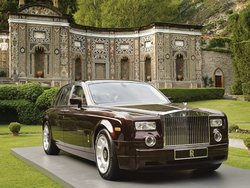 IMAGE CREDITS -Rolls Royce |
 |
 |
 |
 |
 |
 |
Combine the two though – hand-built quality with the intelligent assistance and quality assurance of the latest technology – and it is possible to produce a hand-built car that is right first time, every time. This is one of the things which makes the Rolls-Royce Phantom such a special motor car.
Aluminum Space Frame The Phantom’s aluminium space frame is the largest of its kind ever built for automotive use. Made up of more than 200 extruded aluminium profiles and 300 sheet parts, it combines low weight with extreme strength. The whole bodyshell weighs just 550 kg yet has a torsional rigidity of more than 40,000 Nm/degree – making it at least twice as stiff as any previous Rolls-Royce. Each frame has
120 metres of welds at over 2,000 separate points, every one
completed by hand. The weld at the rear C pillar alone is almost 2
feet long. The expertise of the highly specialised team, based at
Dingolfing, combined with state-of-the-art measuring equipment means
that the entire body is constructed to within a plus / minus
tolerance of just 0.1mm (0.004in). This level of accuracy allows the
coach doors, for example, to clear each other by just 2.7 mm. The driveline of the new Phantom is unique to Rolls-Royce, delivering all the virtues and traditional characteristics of a Rolls-Royce engine, and making use of the latest engineering technology. A Rolls-Royce motor car has a specific type of performance which has been referred to as “waftability“. This means a powerful performance without apparent effort or disturbance to the driver and passengers. To deliver this the power unit needs to produce tremendous levels of torque, extremely smoothly, whatever the engine speed, but especially at low revs. Each engine is hand-built by a team of specialists based in Munich, in the same facility where the BMW M Series engines are produced. Hand-building means that every component can be selected and assembled by some of the most skilled power train engineers in the world. The result is an exceptional engine which has been specifically designed for Rolls-Royce to give exactly the correct power characteristics – quite different to those required for a BMW. It is unique to the marque. This
lightweight, normally aspirated, 6.75 litre V12 engine develops its
peak torque of 720 Nm (531 lb ft) at 3500 rpm – an impressive
figure. More impressive still, is that 78 per cent of this (or 560
Nm) is produced at just 1000rpm – fractionally above tick over.
This makes for smooth, effortless and extremely rapid acceleration
from a standstill. The sprint to 60 mph takes 5.7 seconds (0-100 kph
in 5.9 seconds). About
six times a year, the manager of the interior wood trim meets the
supplier – the only one of its kind in England – to select
personally the veneers for the Phantom. This painstaking process
ensures that the highest quality veneers of the correct colour and
grain characteristics are chosen. Throughout the new Phantom, wood take an architectural form, not merely an ornamental one. Each of the 60 separate panels is constructed of a core wood and an aluminium substrate of up to 40 layers. This lengthy process helps deliver the best crashworthiness properties and means that the wood parts are not simply veneers glued to aluminum or plastic. The craftsmen
hand select the veneers to apply to each panel. A complete “wood
set” of matching and complementary veneers is constructed to give
each individual motor car its own special character. The wood grain
is bookmatched on each panel – the right and left grain structures
are mirror images of each other. More elaborate woodwork to a
customer’s specificiation is also possible. The effect is
aesthetically pleasing and demonstrates the meticulous attention to
detail that is essential for Rolls-Royce.
|
|||||||||||||||||||||||